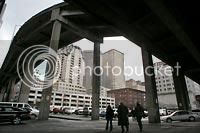Blog Seattle’s Alaskan Way Viaduct And Urban Crime
The replacement of Seattle’s slowly sinking, aged and earthquake-prone Alaskan Way Viaduct has lately been at the center of an unresolved political and planning controversy now entering a much needed cool-down phase.
 Yet the concern remains: what are the effects of large, elevated roadways over busy urban neighborhoods?
Yet the concern remains: what are the effects of large, elevated roadways over busy urban neighborhoods?
The Puget Sound Business Journal reports that in the booming Belltown neighborhood just north of downtown Seattle, the nearby elevated Viaduct helps encourage street drug sales and drug use which has demanded increased police presence and continues apace.
Under the shadow of the Alaskan Way Viaduct, Seattle police officers Katrina Stuckey and Andrew West seize a crack pipe and a rock of cocaine from a woman in Belltown who is about to light up. They’ve seen her many times before — usually without shoes — and she tells them she bought the coke with $10 she found on the street. West enters the incident into a BlackBerry loaded with the names, addresses, birthdays and long list of offenses of the crowd he’s come to know at Western Avenue and Bell Street.
Here in “D3” — the patrol district bordered by Denny Way, Bell Street and the waterfront in Seattle — felony drug arrests jumped 74 percent to 328 in the five-year period that ended last year, according to Seattle police data requested by the Puget Sound Business Journal. Police recorded only 91 felony drug arrests a year in the district as recently as 2004….Belltown’s trend is all the more startling because felony drug arrests throughout downtown Seattle plunged 72 percent to 1,059 during the same time period, police data show.
The gritty intersection of Western and Bell has become a center of downtown drug activity, police say….The intersection’s features also make it suitable for drug activity. The viaduct acts as a dry hiding place where people can sell and use drugs. Drug dealers easily blend into the street crowd of people waiting for jobs outside the CASA Latina day workers’ center.
Police crackdowns in other open air drug markets have helped shift some of that activity to under and near the Viaduct. But the two stacked three-lane roadways have long facilitated nearby loitering and crime, particularly drug sales and drug use, while simultaneously dampening impetus for upgrading the city’s dispirited downtown waterfront.
Seattle has prior experience with how public environments can facilitate crime. Following troubles in Freeway Park, the city enagaged the Project For Public Spaces to develop a communty-based remediation plan, which has led to some positive changes and sparked calls for continued common-sense improvements to the park.
One lesson is that if neighborhoods and public spaces are to be well utilized, they must be made comfortable and attractive, not dark and forbidding. That seems exceedingly basic, but the point manages to get lost sometimes.
A number of neighborhood sources interviewed by the Business Journal for the story about crime in the Viaduct’s shadow report increased police presence has helped. Yet:
…other business owners and residents remain dismayed by illicit activities. Phil’s Custom Bindery, which sits directly across from the viaduct and CASA Latina, will move to South Seattle in April. Scott Goldader, son of the bindery’s founder and a co-owner of the business, said the move was spurred by uncertainty over the viaduct’s future and drug dealing in the neighborhood. Goldader has grown weary of constantly phoning the police because of drug-related activity. “I’m tired of seeing it ongoing every day,” he said. “It makes you feel not right, and angry.”
Obviously, chronic drug abuse is not explained by urban planning, but robust open-air drug markets and other crime can certainly be facilitated by urban design decisions. Cost, capacity and downtown waterfront optimization will drive future decisions on how to replace the Viaduct. In a city more heavily invested each day in residential density – especially in and around downtown – livability and public safety should be no small concerns as the Viaduct debate moves into its next phase over the summer.
Another elevated viaduct would have a very different and much worse effect on the urban fabric for Seattle’s growing downtown population and its many visitors from the region and world; compared to some combination of a taxpayer-friendly deep-bored inland tunnel, and surface transit improvements.
TECHNORATI TAGS: <a href="http://technorati.com/tag/CASCADIA CENTER, SEATTLE, TRANSPORTATION, ALASKAN WAY VIADUCT, CRIME, TUNNEL"rel="tag"CASCADIA CENTER, SEATTLE, TRANSPORTATION, ALASKAN WAY VIADUCT, CRIME, TUNNEL
